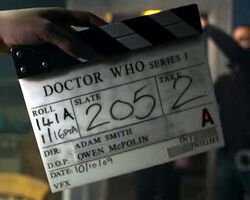Clapperboard: Difference between revisions
(pic add) |
No edit summary |
||
| Line 1: | Line 1: | ||
{{real world}}[[image:clapper.jpg|250px|thumb|A clapperboard from the filming of ''[[The Eleventh Hour]]'']] | {{real world}}[[image:clapper.jpg|250px|thumb|A clapperboard from the filming of ''[[The Eleventh Hour]]'']] | ||
A '''clapperboard''' — sometimes called a '''clapper''', '''slate''', '''sticks''', '''time slate''', '''marker''' or several other names — is | A '''clapperboard''' — sometimes called a '''clapper''', '''slate''', '''sticks''', '''time slate''', '''marker''' or several other names — is an important part of the camera department's toolbox used during [[Principal photography]]. It has several different functions. The information written on it helps to organize the use of the filmed material in [[post-production]]. It also synchronizes sound and picture recording by providing an absolute visual and auditory reference point. | ||
Typically small, hand-held devices, clappers have two pieces of wood or plastic hinged together so that they can be brought together to make a sharp "clap". This noise is used as an absolute auditory reference for the synchronization of the soundtrack of the scene. On most occasions during the filming of the [[BBC Wales]] version of ''Doctor Who'', the board has had the traditional colours of "absolute" white and black, arranged in diagonal slants across the clapping mechanism. These colours are used because they're visible in almost any lighting conditions. However, the production team occasionally use multi-colored clappers. In both cases, the known color values of the clapper are used to provide a colour baseline for the [[colourist]]s and other members of the [[post-production]] team. | Typically small, hand-held devices, clappers have two pieces of wood or plastic hinged together so that they can be brought together to make a sharp "clap". This noise is used as an absolute auditory reference for the synchronization of the soundtrack of the scene. On most occasions during the filming of the [[BBC Wales]] version of ''Doctor Who'', the board has had the traditional colours of "absolute" white and black, arranged in diagonal slants across the clapping mechanism. These colours are used because they're visible in almost any lighting conditions. However, the production team occasionally use multi-colored clappers. In both cases, the known color values of the clapper are used to provide a colour baseline for the [[colourist]]s and other members of the [[post-production]] team. | ||
Revision as of 13:20, 4 April 2010

A clapperboard — sometimes called a clapper, slate, sticks, time slate, marker or several other names — is an important part of the camera department's toolbox used during Principal photography. It has several different functions. The information written on it helps to organize the use of the filmed material in post-production. It also synchronizes sound and picture recording by providing an absolute visual and auditory reference point.
Typically small, hand-held devices, clappers have two pieces of wood or plastic hinged together so that they can be brought together to make a sharp "clap". This noise is used as an absolute auditory reference for the synchronization of the soundtrack of the scene. On most occasions during the filming of the BBC Wales version of Doctor Who, the board has had the traditional colours of "absolute" white and black, arranged in diagonal slants across the clapping mechanism. These colours are used because they're visible in almost any lighting conditions. However, the production team occasionally use multi-colored clappers. In both cases, the known color values of the clapper are used to provide a colour baseline for the colourists and other members of the post-production team.
In addition, clappers contain other information that is of especial use to the assistant editor, whose job it is to organize all incoming foootage for the editor. For reasons of efficiency, however, almost all members of the production and post-production team use at least part of the clapper information in some way to organize their output. On Doctor Who the person in charge of maintaining and using the clappers is the assistant cameraman. If there are two assistants listed in the credits, the clapper loader will usually be the second one (that is, the 2AC). Typically unheralded, and never, as of 2010, included in an interview on Doctor Who Confidential, the 2AC's job is absolutely vital to almost every other department.
Typically, clappers in the BBC Wales era have included the series number and the director and director of photography of a scene. Rarely, the producer's name has also been present. Perhaps more crucially, the clapper will contain a letter designating the camera which produced the shot, a slate number (that is, the number assigned to the particular shot), a take number or code, the date of filming and code designating the place in the actual roll of film (or, if shot digitally, a time marker indicating the place on the memory device). The clapboard also gives an indication of the basic lighting conditions the scene is supposed to have. The 2AC can choose between "interior" and "exterior", and "day" and "night". This is the only part of the clapboard which doesn't actually indicate the conditions as they are, but actually the conditions as they're supposed to be in the final product. Thus, a shot filmed on an exterior location at noon could be marked with "EXT/NIGHT", if the director of photography is shooting "day for night".
Doctor Who is somewhat unusual in that its clappers never indicate the name of the episode being shot. This is ostensibly for security reasons, as it makes it harder for fans who take pictures of location filming to make definitive statements about what they've photographed.
